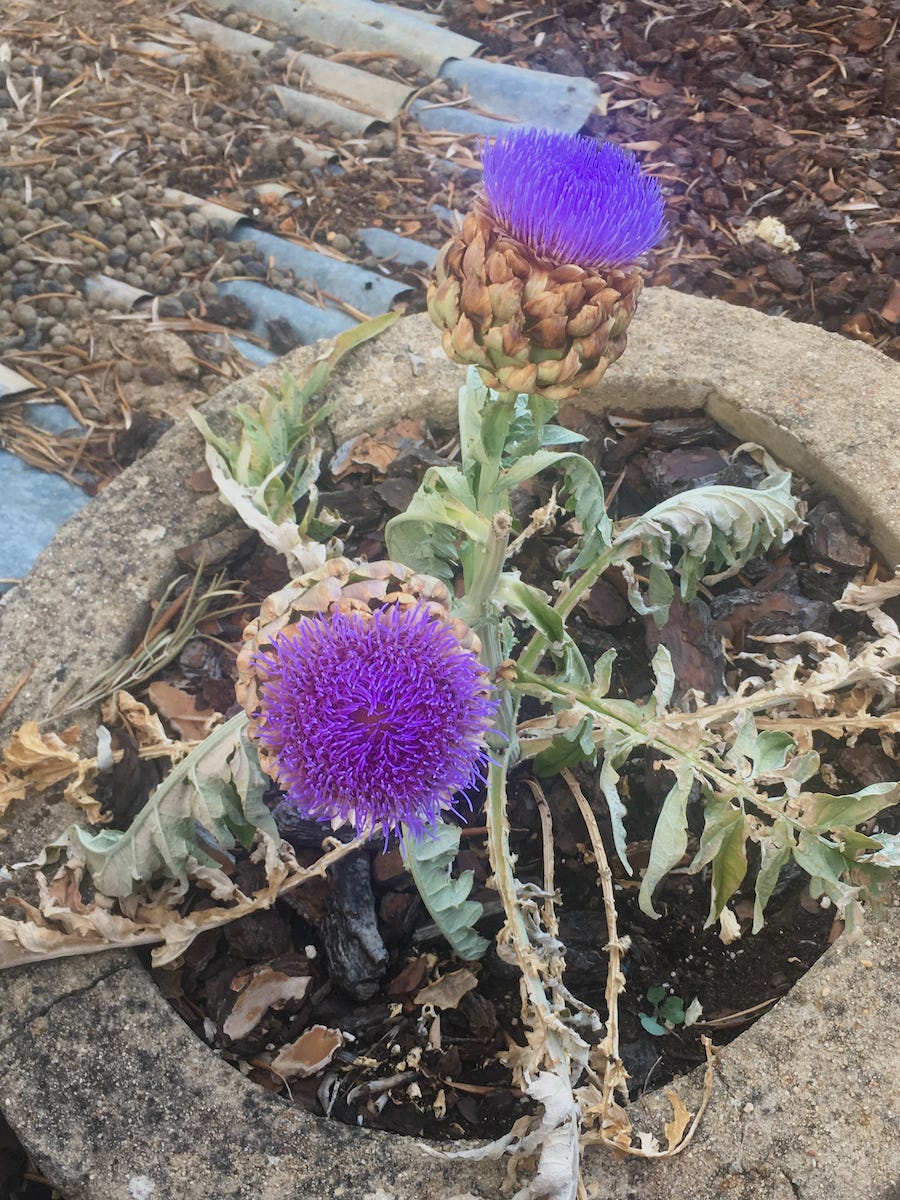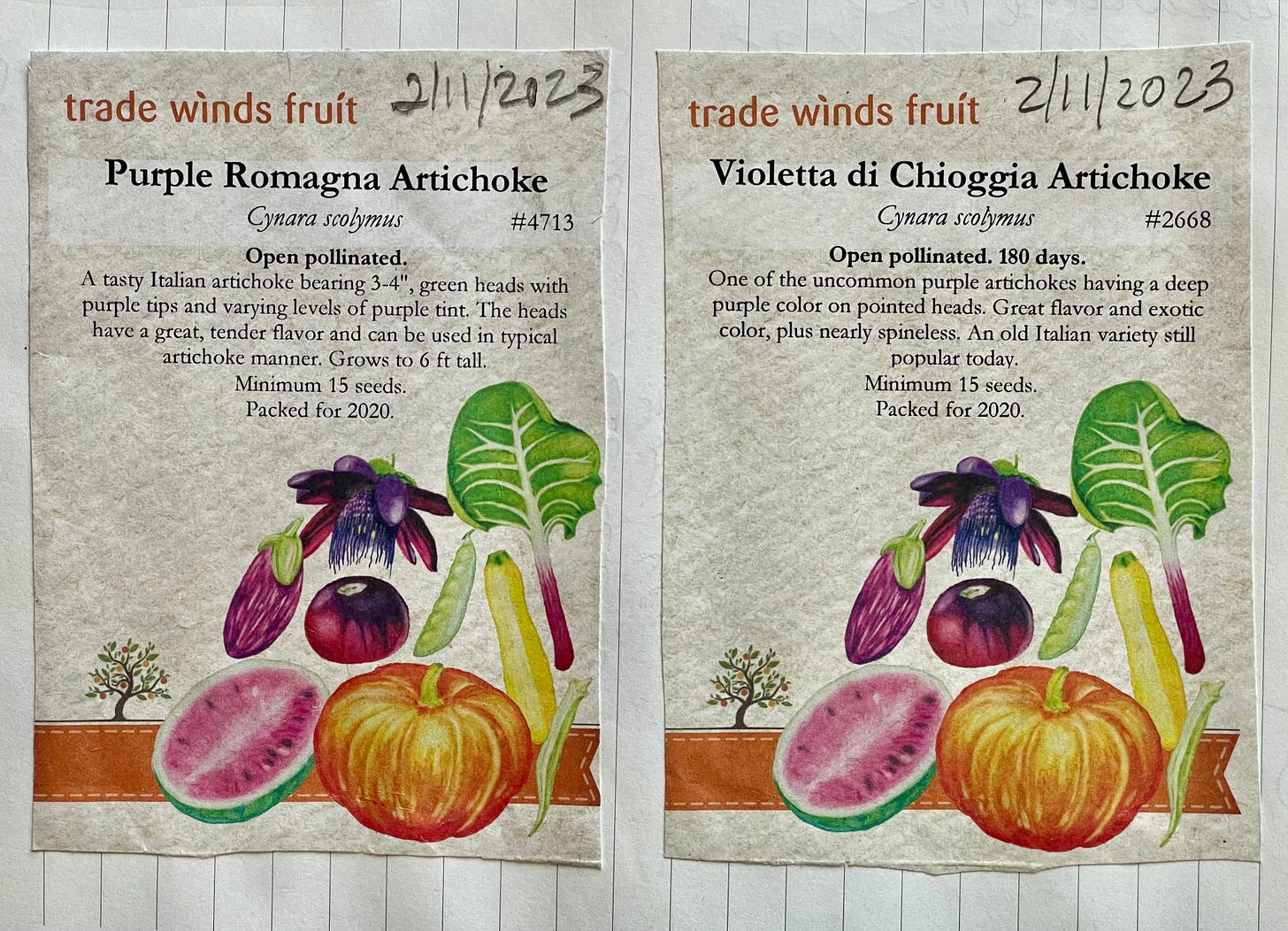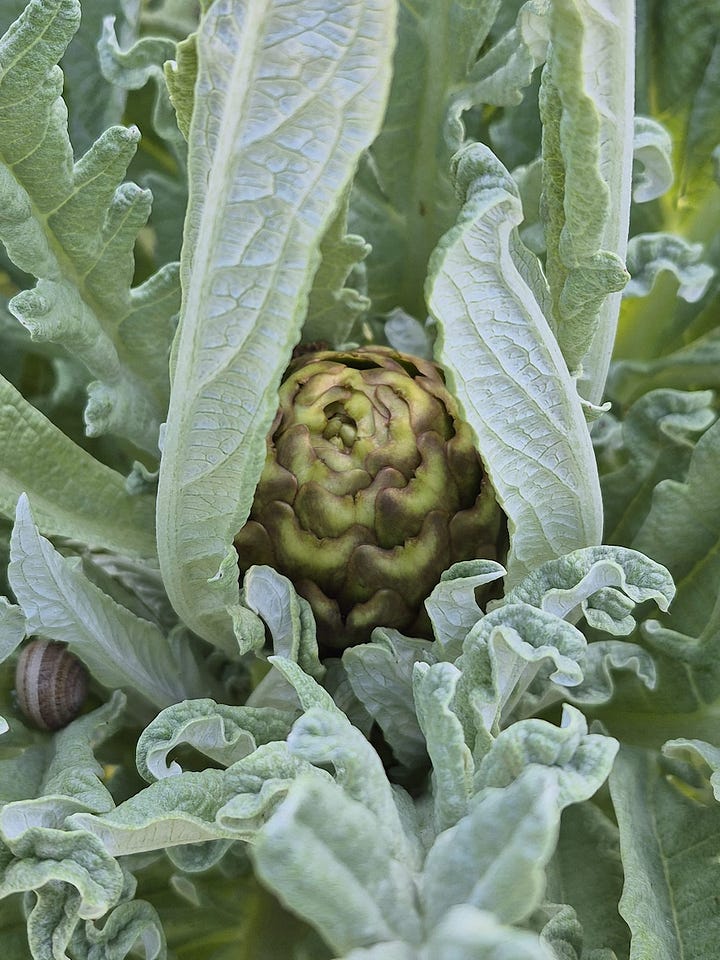Artichokes: another California/Portugal connection
All about this interesting vegetable, which is actually a flower bud
Artichokes were one of my favorite foods growing up in California. Mom always asked us what we wanted for our birthday dinner menu, and my first choice was always artichokes. So while they are daunting to some, I grew up eating and loving the prickly things. This week’s post is all about artichokes: history, botany, how to grow them, how to cook and eat them.
Artichokes are ancient, probably being first cultivated in the Middle East and then discovered and disseminated by the Romans. The word for this plant has had an interesting linguistic journey, beginning as al-kharshüfa, meaning scale in Andalusi Arabic. I haven’t been able to find a translation for scale with this ancient word, but doesn’t it make sense that it would be like a fish scale? Not a weight scale? Jumping from North Africa to Spain, the word in Spanish became alcarchofa. In Portuguese, alcachofra. In Italy, it was called articiocco, a combination of “high” and “stump.” This became artichoke in English. In modern Levantine Arabic, it is now ardi shawki, translating as “earthy, thorny” and coming full circle linguistically!
Artichokes are a thistle, as one can see if the plant is let go to seed—a brilliant violet flower appears as the bud matures and opens up.
Moving up from the roadside weed known as thistle, is cardoon. It is related to artichokes and native to the Mediterranean region. It is a tall plant with a violet flower, and the stems are edible. Cardoon may be used in soups and stews, as the raw plant is quite bitter. In Portugal and Spain, the pistils of the cardoon flower are used as a substitute for rennet in making cheese. Rennet is an enzyme derived from the stomach lining of young ruminant animals such as lambs and calves, so cheese cannot be vegetarian unless cardoon pistils are used.
Artichokes are a perennial plant, meaning they come back every year, and artichokes will produce for several years in ideal conditions. They love the mediterranean climate, which is found around the world in Portugal and Spain, Australia, Chile, South Africa’s Cape and—California!
California produces nearly 100% of the artichokes sold in the US. The town of Castroville in Monterey County declared itself the “Artichoke Center of the World.” A bit of fun trivia: Marilyn Monroe was Castroville’s first Artichoke Queen, in 1948. As a California native, no wonder I grew up eating and loving them!
I’ve never seen an artichoke plant sold in a nursery, though these may exist somewhere. When we moved here to Portugal in 2019, I was thrilled to return to my mediterranean climate roots, and since our property has plenty of space for them, I was determined to grow artichokes. So I had to begin from seed, which I did four years ago. My first plant was the typical, standard variety: Green Globe.
I ended up putting it in an empty planter and it did fine. Until the Sahara heat of the Algarvian summer, when it went to flower and the rest of the plant dried up. I thought it was dead and gone.

The rains came in October, and the thing sprang back to life!
So it turns out that the plant goes dormant in the heat, and seems to disappear. When I had success with my first attempt, I decided to go for some different varieties, and I bought two packets of seed:

And a friend gave me some heirloom seeds she bought in Italy. I then proceeded to pull one of my favorite gardening tricks: losing track of which plant starts were from which seeds. I had labeled them but the labels got separated somehow. I always think I’ll remember, and of course I never do.


When I was doing maintenance around the plants in early spring, one bit me big-time, and turned out be covered with really vicious thorns, even on the leaves and stalks. Much worse than the other varieties. This is a Darth Vader kind of artichoke—dark purply-brown with wild spikes at the ends of the leaves.
Apparently there is a spineless version of artichoke, but it is grown as an annual because it doesn’t come back, which is probably best in cold climates. I’ll stick with my spiny plants, and make sure I use leather gloves around them. I learned to warn supermarket cashiers in the US as an unsuspecting person will grab the plastic bag and get stung if they’re not careful. Most people buy artichokes in a can or a jar so having to deal with the vegetable itself is not that common in America.
And now for the fun part: how to eat them. It’s important to pick them while the leaves are tightly closed, like a rosebud. When the leaves open up and separate the artichoke becomes woody and tough. Cut the stem below the artichoke; the stem is also edible if the plant is young. Wash thoroughly under cool running water, from the top of the artichoke down.
I like to steam or boil them, and I add a smashed garlic clove, a few whole cloves and some lemon juice to the water. Artichokes are worse than apples or pears for turning brown when cut and exposed to air, and lemon juice helps with that. Here’s a video of Martha Stewart showing how. Say what you will about Martha, she has skills!
Boil or steam until a leaf comes loose easily, indicating it’s ready to eat. Sit down with the artichoke on a plate and a big bowl to throw the leaves in after you eat them. Pick off a leaf and put the base between your teeth and pull, the meat is so delicious! I don’t know if other people call it meat, but it’s very meaty though there’s only a small amount on each leaf.
My heirloom varieties are so good that I eat them without a sauce, but various dipping sauces are usually served. Favorites are lemon or garlic in melted butter, but middle-class Californians like mayonnaise, I hate to admit. Arlene (my mom) used to suggest I really wanted to eat mayonnaise, and the artichoke leaves were just an excuse.


Once you have eaten all the leaves, you are down to the choke. Pull off the thin remaining leaves to reveal the choke, the thistly part. People usually cut it out with a knife, but that is wasteful to me as you inevitably cut off some of the good stuff. I learned to grab the choke and pull it off. Then you have the amazingly tasty artichoke heart.
Now that I have artichoke plants I get to experiment with ways of using them when they’re young and small. In one new recipe I prepared the hearts of small artichokes by trimming them, then cooked them from raw with a cut-up chicken in a shallot-white wine braise. Super delicious! Here’s another video showing how to prepare artichoke hearts from fresh.
Artichokes have always been such a treat to me that I was amazed to discover they are considered a super food! They are said to be good for lowering cholesterol, probably because they are high in fiber. They are also apparently touted as a hangover cure, but don’t ask me why!
Artichokes are high in potassium, Vitamin K and fiber. Another key ingredient is cynarin, which in alternative health circles is said to promote bile production, prevent gallstones and promote urination. It is also said to prevent the accumulation of fats in the arteries—a good thing if you’re scooping up mayonnaise or melted butter with your artichoke leaves!
If you haven’t tried fresh artichokes before, dear reader, I hope I’ve piqued your interest. Go ahead, give them a try next time they’re in season! So much better than those bland things in a can—though I resort to those upon occasion too. Can’t have too many artichokes!








I confess…I’ve never had an artichoke but now I’m intrigued!
Love love artichokes! Here in Italy they are called carciofi (plural of carciofo), probably a shortened version of the word you found earlier. My favorite way to eat them is as a salad. In the early spring the young centers are tender enough to slice thinly, toss with lemon juice, olive oil and a bit of Parmesan and enjoy! When the grocer has a surplus, I will also make pasta from several hearts and the tender bits scraped from the inner leaves. Delish!